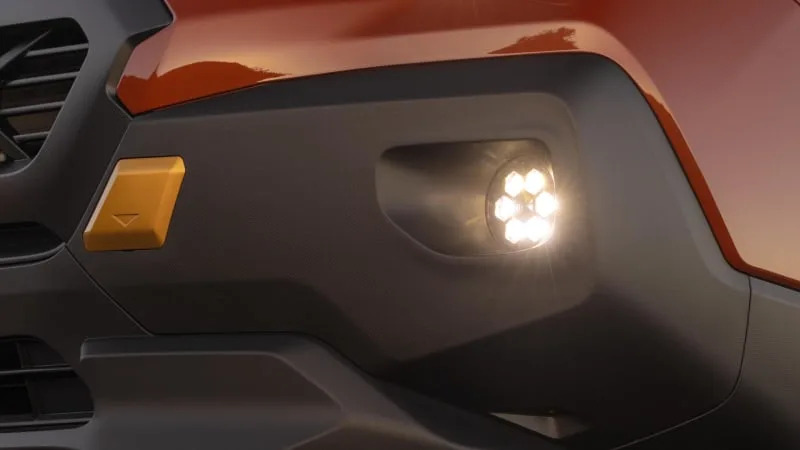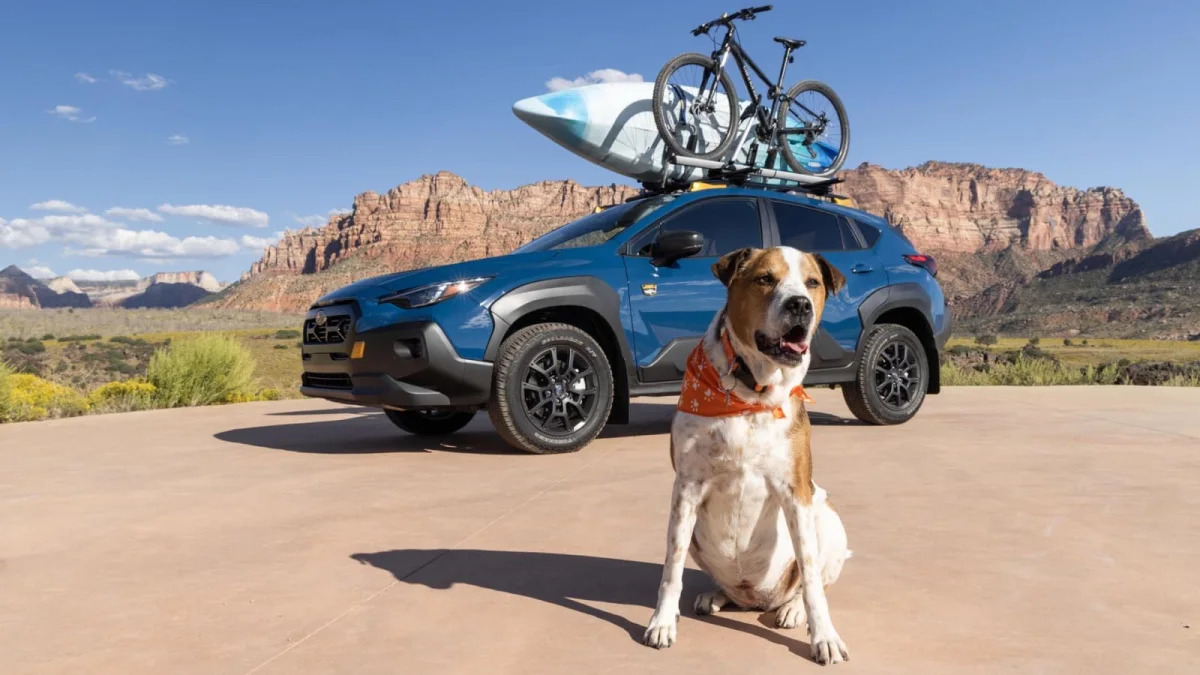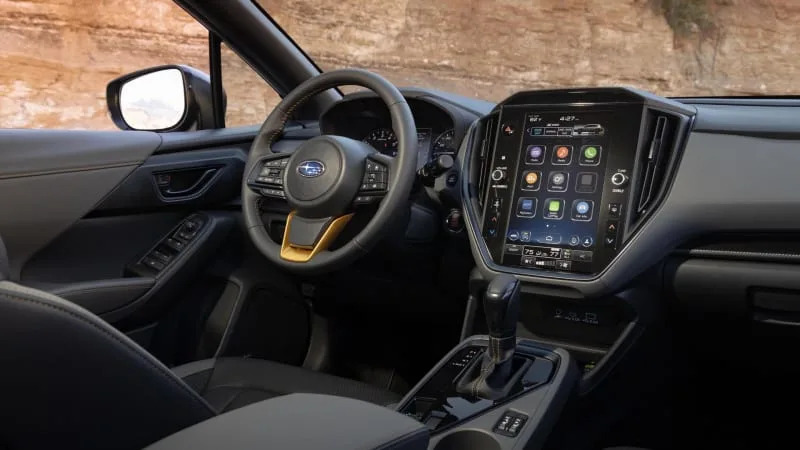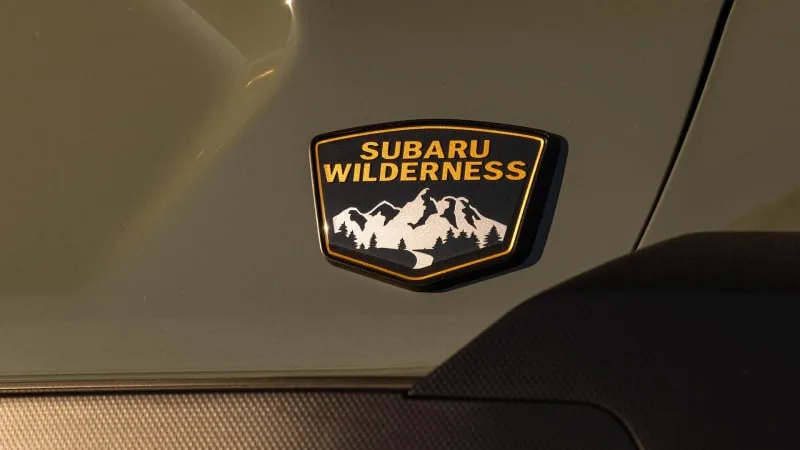SPRINGDALE, Utah — You’re right, a 2024 Subaru Crosstrek Wilderness in Zion National Park does look like something out of a marketing brochure. But come on, it’s hard to argue with this kind of product placement. The new Crosstrek Wilderness is 100% geared toward the hashtag-active-lifestyle outdoorsy types who flock to Zion every year. Or, at least, it’ll do a good job convincing your friends that you’re one of the hashtag-active-lifestyle outdoorsy types who wants to make the trek to Zion. You know, when work settles down.
The Crosstrek Wilderness definitely has butch aesthetics on lock, with new bumpers, a matte black hood, and mega wheel arch and door cladding. But all of these upgrades are legitimately functional – the matte decal reduces glare, the bumpers improve off-road geometry (and can be easily replaced) and the cladding protects other precious bits of sheetmetal. On top of that, the Wilderness has 17-inch wheels wrapped in 225/60 Yokohama Geolandar all-terrain tires, a front underbody skid plate and redesigned roof rails that can support up to 700 pounds when you’re parked or 176 on the move.
The standard 2024 Crosstrek is already a little billy goat in its own right, but with approach, departure and breakover angles of 20.0, 33.0 and 21.1 degrees, respectively, the Wilderness is pretty stinkin’ capable. All are 2 to 3 degrees better than the standard Crosstrek. Major credit goes to the 0.6-inch improvement in ground clearance, giving you 9.3 total inches of drive-over-it prowess. For reference, that’s only a tenth of an inch less than a base Jeep Wrangler.


With all these upgrades working in tandem, the Crosstrek Wilderness scurries up and over the sandy, rutted hills near Zion, and makes quick work of rocky roads leading up to beautiful mesa overlooks. Unique Snow/Dirt and Deep Snow/Mud programming for the X-Mode all-wheel-drive system lets the traction control spin the wheels a little more freely, and adjusts the torque split for better power delivery. Yes, the main goal with this system is to give the driver more confidence in sticky situations, but there’s an added benefit: Dirt/Snow will actually let the Crosstrek’s rear end get a little more playful on gravel roads. It’s no rally car, obviously, but you can pretend.
Well, kind of. The Crosstrek Wilderness is many things – fun included – but it’s definitely not quick. The Wilderness uses the same 2.5-liter naturally aspirated flat-four engine as the Crosstrek Sport and Limited models, which is good, since the Crosstrek’s base 2.0-liter engine is, like, molasses slow. The 2.5’s 182 horsepower and 178 pound-feet of torque still aren’t anything to write home about, but at least Subaru retuned the continuously variable transmission to have a higher final drive ratio – 4.1:1, up from 3.7:1 – which improves low-end response. But it’s not like you’re buying a Crosstrek for its fleetness, anyway.
Instead, the Crosstrek Wilderness impresses with its comfortable ride quality and the general vibe that you can drive the doors off it and bash it into sand dunes and know that it’ll keep on truckin’. Surprisingly, on pavement, the Wilderness doesn’t have a lot of road noise despite being fitted with all-terrain tires, and wind noise is relatively minor, too. A commanding seating position and low cowl makes the Crosstrek easy to drive both in town and on the freeway, and while the steering is pretty light, it’s got a nice amount of feedback. Like all Crosstreks, the Wilderness would make a super-pleasant daily driver. It’ll even return a respectable 27 mpg combined.
The Crosstrek’s standard EyeSight driver-assistance suite carries over to the Wilderness, and Subaru made a point to reprogram the tech to account for this model’s added ground clearance and different tires. A stronger transmission cooler and more powerful radiator fans improve the engine’s capabilities, too, and allow the Wilderness to tow 3,500 pounds – a nice improvement over the Crosstrek Sport’s 1,500-pound rating.
Like its exterior, the Crosstrek Wilderness’ interior is designed to be used and abused. The seat upholstery looks and feels a little like vinyl, but it’s waterproof, and the front chairs are comfy. Rugged floor mats will handle the gunk from your muddy boots, and there’s a removable and washable mat in the cargo area, which is good, because if you’re a Crosstrek Wilderness owner with muddy boots, you probably have a bunch of other muddy stuff, too.
The standard cabin tech loadout includes Subaru’s 11.6-inch portrait-oriented touchscreen, which looks impressive – well, when the car is off. Fire up the Crosstrek and you’ll be greeted by Subaru’s Starlink software, which was outdated the moment it was introduced, with low-res graphics and slow responses to inputs. At least Apple CarPlay and Android Auto connect wirelessly, and the optional Harman/Kardon stereo sounds halfway decent – not something to be said about most other Subarus.


That premium audio system is included in a $2,270 package that also includes a power driver’s seat with lumbar support and a sunroof. That’s the only available add-on for the Crosstrek Wilderness, save for cool dealer-installed accessories like mud flaps, dog-friendly convenience features and even a roof tent for those stronger roof rails. Pricing for the 2024 Crosstrek Wilderness starts at $33,290 including a $1,295 destination charge, and with the aforementioned factory option pack, a fully loaded version rings up for $35,560. That’s a pretty killer deal.
Not that any prospective Crosstrek Wilderness buyer will need convincing, of course. Like the previously introduced Outback and Forester Wilderness models, the Crosstrek version is the direct result of Subaru’s customer feedback, learned after years of watching buyers build their own off-road-modded SUVs. Right now, Wilderness models account for 20% of all Forester and Outback sales, meaning there’s clearly an audience for this sort of rugged glow-up. Adding the Crosstrek Wilderness to Subaru’s portfolio is a no-brainer. This thing’s going to sell itself.
Read the full article here


